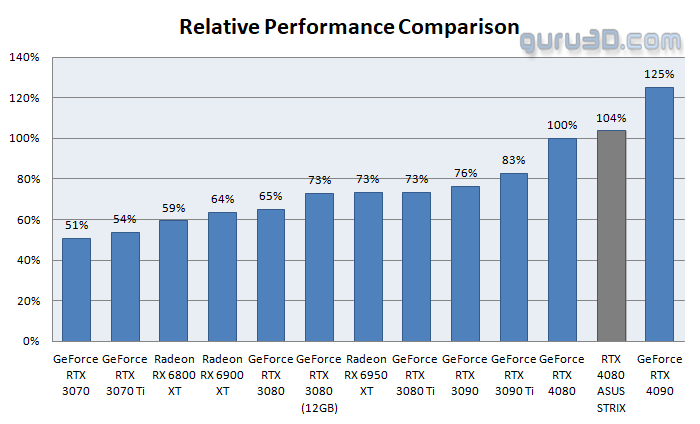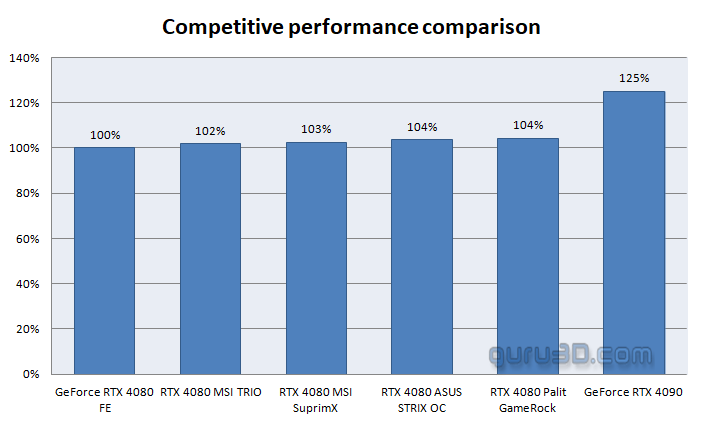Final words and conclusion
Final words
It has been a while since we had an ASUS STRIX in the house, and the company has since implemented a fresh look. It took me some time to adjust to that more artistic style. Looks, however, are an opinion and are subjective. Before I go any further, let me state that the size and weight of this item—nearly 2.5 Kg and approximately 36cm—are very remarkable. That is hardly what I would call progress, but it is what this GPU requires. And when you put the two together, you get a high-performance product that operates at a whisper-quiet 33 dB in silent BIOS mode and stays comfortably below 60 degrees Celsius in temperature. From a raw shader perspective, this product delivers a substantial performance gain over the previous generation. We must also highlight the significant increase in raytracing speed and the addition of raytracing functionality. This time around, though, NVIDIA is betting even bigger on DLSS with considerably upgraded Tensor cores that aid DLSS 3.0, which currently offers a twofold performance boost. With correct implementation in future games, NVIDIA claims a 3x or 4x performance boost, which is stunning numbers. There, however, is a discussion as to what frame injections really bring to the table other than higher framerates. In the end, though, the eye candy on your monitor is what counts, and we cannot complain here. We're not sure yet what the STRIX OC will be priced at, but if we apply a default ASUS premium of 20%, we're looking at ~1450 USD. PC gaming has become increasingly expensive, driving end users to other solutions. Admittedly also, the new power connector raises concerns. It's not that it's not a safe connector; it's just that bending them too close to the connector combined with sometimes poor quality can lead to hazardous situations. Suppose you need to bend that cable, do it 3-4cm above the connector level. Also, make sure you insert it correctly. All and rally, ALL cards we have tested to date we have checked with FLIR imaging, and for us, none ever and whatsoever has shown an issue.
Performance
You've seen the numbers, and we've already let the cat out of the bag. It all comes down to gaming performance and, of course, rendering quality. Yes the RTX 4080 provides more value for the money than seen from the 4090, as we're getting close to raw performance levels that easily enable gaming at 4K resolution. Most enthusiast gamers play at UWHD, QHD, or UHD monitor resolutions. This card is designed for precisely that kind of gamer.
The old rasterizer engine breaks right through the previous limit of extreme performance. Because of the 9K Shading processors, all of this is possible. The RTX 40 series now has a new generation of Ray tracing and Tensor cores that are more powerful. So, do not let the specific RT and Tensor core counts fool you; it's all about how much performance one unit offers. Since they are close to the shader engine, they have become more efficient, which shows. Tensor cores are harder to measure, but from what we have seen, everything seems to be in good shape, as DLSS3 shows exciting values. Overall, the GeForce RTX 4080 makes sense at resolutions as low as 2K 2560x1440, up to 4K (3840x2160).
Cooling & noise levels
ASUS offers something massively in size and weight, but that surely does help cooling. Under full load, the founder edition uses about 330 Watts (average). This Wattage is directly related to how much heat the GPU, which sits inside a closed case, gives off. For acoustics, we reached 38 dBA in highly stressed conditions for the performance mode BIOS, however 33 DBa in silent mode BIOS, and that is extraordinary. It took a while for the card to get there (it warms up slowly), but even that is considered a normal acoustic value. Expect the card to get close to 60°C when it's under a lot of stress. This value can go up depending on how well air moves through your chassis. FLIR imaging doesn't show anything scary.
Energy
We touched the topic a bit; the power draw under intensive gaming for GeForce RTX 4080 is high, especially when energy prices are soaring; this product isn't a good example. We measured it to be close to the 330 Watt range, and ASUS will all 360 Watt when tweaked. This is the tradeoff for a bit more bite in performance for this graphics card model in particular. Gaming wise that number will fluctuate a bit; however, 275+ Watt it'll do in no time. We expect the board partner cards to show higher numbers as they get more TGP allowance.
Coil whine
The GeForce RTX 4080 STRIX exhibits extensive coil whine. Unfortunately, our sample was pretty bad, a bit of a squeaky scream pig even. That has surprised us; no, that's not good. Out of all 4080 cards tested to date, this particular ASUS one was the worst.
Pricing
The reference/founder edition of NVIDIA's GeForce RTX 4080 costs USD 1199, which is too much for most of us to pay for something that can be used to play PC games. This product is so unique that it has its market. NVIDIA might have been able to charge even more for the product and still sell a lot of them. We do not know the MSRP for the ASUS STRIX OC just yet but expect that value to sit at 1400, maybe 1500 USD. If that's the case with pricing, we'd rather steer you to a founder 4090.
Tweaking
Regardless the card tweaks well. The GPU constantly hits the power limiter with the high +16% power limiter, so that's your first and quickest option to tweak. You get extra perf on the card's default power budget. The clock frequency can take a good +150 MHz extra. Apply it, and you'll see the GPU boost clock hovering in the 3000~3050 MHz domain (frequencies vary per game title as they are dynamic). The memory could be tweaked to over 24 Gbps, so all these are terrific values that brought 4~7% additional performance on challenging GPU situations, measured from founder edition reference performance. Tweaking-wise, we're not confident that 16 % extra wattage is worth 5~6% extra performance.
Conclusion
ASUS's ROG Strix GeForce RTX 4080 OC Edition graphics card is a knockout, and the revamped design is the card's calling card. This card's striking configuration departs from the familiar appearance of prior ROG Strix products, guaranteeing that you will not be able to take your eyes off it. We're impressed and surprised to notice what STRIX brings to the table. First off though, you'll need space to fit this card in your PC; 36cm, 2.4kg and 3.5 slots thick hits a specific panic button on my end. But in the end, all values returned are right with low temps, low noise and high performance. I am, however, not amused about the coil whine we got from this card; it was pretty bad. Some will hate that; others are not bothered, I guess. From a hardware and performance point of view, the GeForce RTX 4080 is downright fantastic. However, we live in challenging times, with a war close to the EU border, and soaring energy prices, life has gotten much harder and expensive. That does make products like those shown today harder to defend; then again we can't blame NVIDIA for the state of the world in 2022. We hope to see affordable low-energy products sooner rather than later from NVIDIA. As a piece of hardware all by itself, we can only applaud the 4080. The ADA GPU architecture can perform skillfully and excellently. A good chunk of extra shader cores brings in nearly 1.5x raw shader performance and even better Raytracing and Tensor core performance. Underlying technologies like Shader Execution Reordering (SER) and DLSS 3.0 make the new product and Series 4000 shine.The GeForce RTX 4080 offers staggering numbers. Starting at $1199, however, it's very expensive. If you have the wallet leniency and play games in Ultra HD or at the very least start at a monitor resolution of 2560x1440, we can't argue that it'll be a great addition towards any enthusiast-class gaming rig. Take Microsoft Flight Simulator 2020 combined with DLSS 3.0, you can fly at 100+ FPS in the highest resolutions. Cyberpunk at UHD with raytracing and DLSS3 quickly passes 100 FPS. This purebred Ultra HD card shines in that area, whether shading (regularly rendered games) or hybrid ray-tracing + DLSS3 is used. Compared to the mighty 4090, this still is a more economical product series offering massive performance.
Aside from pricing, the ASUS RTX 4090 ROG Strix's card revamp is something we enjoy. The Strix looks sleek and cutting edge by switching to the popular streaming colours of blue and red. Even though the width and length are at the very top of what any case, let alone mid-towers, can take, the card is perfectly rounded. It's heavy though, at 2.5kg. At the very least, they have provided us with a simple card stand, albeit not an issue thanks to the exceptional build quality we would expect from anything bearing a ROG logo. The ASUS GeForce RTX 4080 graphics card is a fantastic addition to the ROG Strix family of products, and it is ready to take on any holiday gaming challenge you can throw at it. You should only use it with a 4K display capable of 120 frames per second or more.
Sign up to receive a notification when we publish a new article.
Or go back to Guru3D's front page
- Hilbert, LOAD"*",8,1.




